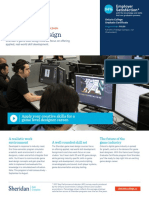0% found this document useful (0 votes)
362 views2 pagesIntroduction To Game Development
The document provides an overview of game development, outlining the process from conceptualization through release. It discusses the history and evolution of games, the roles of designers, programmers, artists, and producers. Game development tools like engines, IDEs, and asset software are also reviewed. The document examines challenges like advancing technologies and saturated markets, as well as opportunities in platforms from consoles to mobile.
Uploaded by
jerikbenito46Copyright
© © All Rights Reserved
We take content rights seriously. If you suspect this is your content, claim it here.
Available Formats
Download as DOCX, PDF, TXT or read online on Scribd
0% found this document useful (0 votes)
362 views2 pagesIntroduction To Game Development
The document provides an overview of game development, outlining the process from conceptualization through release. It discusses the history and evolution of games, the roles of designers, programmers, artists, and producers. Game development tools like engines, IDEs, and asset software are also reviewed. The document examines challenges like advancing technologies and saturated markets, as well as opportunities in platforms from consoles to mobile.
Uploaded by
jerikbenito46Copyright
© © All Rights Reserved
We take content rights seriously. If you suspect this is your content, claim it here.
Available Formats
Download as DOCX, PDF, TXT or read online on Scribd
/ 2













































































































